Deck 18: Aromatic Compounds
Question
Question
Question
Question
Question
Question
Question
Question
Question
Question
Question
Question
Question
Question
Question
Question
Question
Question
Question
Question
Question
Question
Question
Question
Question
Question
Question
Question
Question
Question
Question
Question
Question
Question
Question
Question
Question
Question
Question
Question
Question
Question
Question
Question
Question
Question
Question
Question
Question
Question
Question
Question
Question
Question
Question
Question
Question
Question
Question
Question
Question
Question
Question
Question
Question
Question
Question
Question
Question
Question
Question
Question
Question
Question
Question
Question
Question
Question
Question
Question

Unlock Deck
Sign up to unlock the cards in this deck!
Unlock Deck
Unlock Deck
1/98
Play
Full screen (f)
Deck 18: Aromatic Compounds
1
Which of the following is another name for 4-chlorobenzaldehyde?
A) o-chlorobenzaldehyde
B) m- chlorobenzaldehyde
C) p-chlorobenzaldehyde
D) styrene
E) 1-chlorobenzaldehyde
A) o-chlorobenzaldehyde
B) m- chlorobenzaldehyde
C) p-chlorobenzaldehyde
D) styrene
E) 1-chlorobenzaldehyde
p-chlorobenzaldehyde
2
What is the IUPAC name for the following compound? 
A) 5-bromo-4-nitroaniline
B) 5-bromo-p-nitroaniline
C) 1-bromo-2-nitroaniline
D) 3-bromo-4-nitroaniline
E) p-nitro-m-bromoaniline

A) 5-bromo-4-nitroaniline
B) 5-bromo-p-nitroaniline
C) 1-bromo-2-nitroaniline
D) 3-bromo-4-nitroaniline
E) p-nitro-m-bromoaniline
3-bromo-4-nitroaniline
3
What is the structure for 4-amino-2-bromophenol? 
A) I
B) II
C) III
D) IV
E) V

A) I
B) II
C) III
D) IV
E) V
II
4
o-xylene is the common name for:
A) hydroxybenzene
B) aminobenzene
C) 1,2-dimethylbenzene
D) ethylbenzene
E) 1,3-dimethylbenzene
A) hydroxybenzene
B) aminobenzene
C) 1,2-dimethylbenzene
D) ethylbenzene
E) 1,3-dimethylbenzene

Unlock Deck
Unlock for access to all 98 flashcards in this deck.
Unlock Deck
k this deck
5
For disubstituted benzene derivatives, the descriptors ortho, meta, para are used when the parent is usually a ________.

Unlock Deck
Unlock for access to all 98 flashcards in this deck.
Unlock Deck
k this deck
6
What is the IUPAC name for the following compound? 
A) 5-bromophenol
B) 3-bromophenol
C) 5-bromoaniline
D) 3-bromoaniline
E) 1-bromophenol

A) 5-bromophenol
B) 3-bromophenol
C) 5-bromoaniline
D) 3-bromoaniline
E) 1-bromophenol

Unlock Deck
Unlock for access to all 98 flashcards in this deck.
Unlock Deck
k this deck
7
What is the IUPAC name for the following compound? 


Unlock Deck
Unlock for access to all 98 flashcards in this deck.
Unlock Deck
k this deck
8
When the benzene ring is treated as a substituent, it is called a _________ group

Unlock Deck
Unlock for access to all 98 flashcards in this deck.
Unlock Deck
k this deck
9
Anisole is the common name for:
A) hydroxybenzene
B) aminobenzene
C) methylbenzene
D) ethylbenzene
E) methoxybenzene
A) hydroxybenzene
B) aminobenzene
C) methylbenzene
D) ethylbenzene
E) methoxybenzene

Unlock Deck
Unlock for access to all 98 flashcards in this deck.
Unlock Deck
k this deck
10
What is the structure for 1,3-diphenylbutane?

Unlock Deck
Unlock for access to all 98 flashcards in this deck.
Unlock Deck
k this deck
11
What is the correct structure for 4-amino-2-chlorophenol? 
A) I
B) II
C) III
D) IV
E) V

A) I
B) II
C) III
D) IV
E) V

Unlock Deck
Unlock for access to all 98 flashcards in this deck.
Unlock Deck
k this deck
12
Toluene is the common name for:
A) hydroxybenzene
B) aminobenzene
C) methylbenzene
D) ethylbenzene
E) methoxybenzene
A) hydroxybenzene
B) aminobenzene
C) methylbenzene
D) ethylbenzene
E) methoxybenzene

Unlock Deck
Unlock for access to all 98 flashcards in this deck.
Unlock Deck
k this deck
13
What is the IUPAC name for the following compound? 
A) 4-butylphenol
B) 1-sec-butylphenol
C) 4-propylphenol
D) 4-sec-butylphenol
E) 1-isobutylphenol

A) 4-butylphenol
B) 1-sec-butylphenol
C) 4-propylphenol
D) 4-sec-butylphenol
E) 1-isobutylphenol

Unlock Deck
Unlock for access to all 98 flashcards in this deck.
Unlock Deck
k this deck
14
What is the IUPAC name for the following compound? 
A) 6-ethyl-3-nitrobenzoic acid
B) 1-ethyl-4-nitrobenzoic acid
C) 2-ethyl-5-nitrobenzoic acid
D) 2-ethyl-5-nitrobenzaldehyde
E) 4-nitro-3-carboxyethylbenzene

A) 6-ethyl-3-nitrobenzoic acid
B) 1-ethyl-4-nitrobenzoic acid
C) 2-ethyl-5-nitrobenzoic acid
D) 2-ethyl-5-nitrobenzaldehyde
E) 4-nitro-3-carboxyethylbenzene

Unlock Deck
Unlock for access to all 98 flashcards in this deck.
Unlock Deck
k this deck
15
What is the common name for the following compound? 


Unlock Deck
Unlock for access to all 98 flashcards in this deck.
Unlock Deck
k this deck
16
Phenol is the common name for:
A) hydroxybenzene
B) aminobenzene
C) methylbenzene
D) ethylbenzene
E) methoxybenzene
A) hydroxybenzene
B) aminobenzene
C) methylbenzene
D) ethylbenzene
E) methoxybenzene

Unlock Deck
Unlock for access to all 98 flashcards in this deck.
Unlock Deck
k this deck
17
What is the IUPAC name for the following compound? 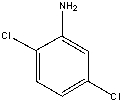
A) 3,4-dichloroaniline
B) 2,4-dichloroaniline
C) 2,5-dichloroaniline
D) 3,6-dichloroaniline
E) 2,6-dichloroaniline

A) 3,4-dichloroaniline
B) 2,4-dichloroaniline
C) 2,5-dichloroaniline
D) 3,6-dichloroaniline
E) 2,6-dichloroaniline

Unlock Deck
Unlock for access to all 98 flashcards in this deck.
Unlock Deck
k this deck
18
What is the correct order of the names for the following compound? 
A) I-naphthalene; II-triphenyl; III-biphenyl
B) I-naphthalene; II-phenanthrene; III-biphenyl
C) I-biphenyl; II-anthracene; III-naphthalene
D) I-naphthalene; II-anthracene; III-biphenyl
E) I-biphenyl; II- phenanthrene; III-naphthalene

A) I-naphthalene; II-triphenyl; III-biphenyl
B) I-naphthalene; II-phenanthrene; III-biphenyl
C) I-biphenyl; II-anthracene; III-naphthalene
D) I-naphthalene; II-anthracene; III-biphenyl
E) I-biphenyl; II- phenanthrene; III-naphthalene

Unlock Deck
Unlock for access to all 98 flashcards in this deck.
Unlock Deck
k this deck
19
What is the structure for p-aminobenzoic acid (PABA)?

Unlock Deck
Unlock for access to all 98 flashcards in this deck.
Unlock Deck
k this deck
20
What is the IUPAC name for the following compound? 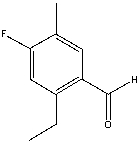


Unlock Deck
Unlock for access to all 98 flashcards in this deck.
Unlock Deck
k this deck
21
Using a Frost circle, draw the molecular orbital energy diagram for the cyclopropenyl anion  and predict if it is aromatic.
and predict if it is aromatic.
 and predict if it is aromatic.
and predict if it is aromatic.
Unlock Deck
Unlock for access to all 98 flashcards in this deck.
Unlock Deck
k this deck
22
Using a Frost circle, draw the molecular orbital energy diagram for the cyclononatetraenyl cation  and predict if it is aromatic.
and predict if it is aromatic.
 and predict if it is aromatic.
and predict if it is aromatic.
Unlock Deck
Unlock for access to all 98 flashcards in this deck.
Unlock Deck
k this deck
23
What is the IUPAC name for the following compound? 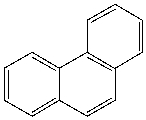


Unlock Deck
Unlock for access to all 98 flashcards in this deck.
Unlock Deck
k this deck
24
According to molecular orbital theory, how many -antibonding molecular orbitals are there for benzene?
A) 1
B) 2
C) 3
D) 4
E) 5
A) 1
B) 2
C) 3
D) 4
E) 5

Unlock Deck
Unlock for access to all 98 flashcards in this deck.
Unlock Deck
k this deck
25
Which of the following describes the current view of the two Kekulé structures for benzene?
A) they are both correct structures for benzene
B) the two structures are in equilibrium
C) the two structures adequately describes benzene;
D) benzene is a resonance hybrid of the two structures
E) None of the above
A) they are both correct structures for benzene
B) the two structures are in equilibrium
C) the two structures adequately describes benzene;
D) benzene is a resonance hybrid of the two structures
E) None of the above

Unlock Deck
Unlock for access to all 98 flashcards in this deck.
Unlock Deck
k this deck
26
What is the main difference between an aromatic and antiaromatic compound?
A) Aromatic compounds must be cyclic and planar, but not antiaromatic compounds
B) Aromatic compounds must be monocyclic.
C) Antiaromatic compounds must have a conjugated system with p orbital at every vertex
D) Aromatic compounds must satisfy Hückel's rule.
E) none of these
A) Aromatic compounds must be cyclic and planar, but not antiaromatic compounds
B) Aromatic compounds must be monocyclic.
C) Antiaromatic compounds must have a conjugated system with p orbital at every vertex
D) Aromatic compounds must satisfy Hückel's rule.
E) none of these

Unlock Deck
Unlock for access to all 98 flashcards in this deck.
Unlock Deck
k this deck
27
What is the structure for 3-isobutyl-5-isopropylaniline?

Unlock Deck
Unlock for access to all 98 flashcards in this deck.
Unlock Deck
k this deck
28
The number of π electrons present in an antiaromatic compound:
A) 4n + 2
B) 2n + 2
C) 4n
D) none
E) none of these
A) 4n + 2
B) 2n + 2
C) 4n
D) none
E) none of these

Unlock Deck
Unlock for access to all 98 flashcards in this deck.
Unlock Deck
k this deck
29
The carbon-carbon bonds in benzene are _________.
A) of equal length and are shorter than the double bond
B) of equal length and are midway between a single bond and a double bond
C) of equal length and are longer than the single
D) of unequal length and alternate as single and double bond
E) none of these
A) of equal length and are shorter than the double bond
B) of equal length and are midway between a single bond and a double bond
C) of equal length and are longer than the single
D) of unequal length and alternate as single and double bond
E) none of these

Unlock Deck
Unlock for access to all 98 flashcards in this deck.
Unlock Deck
k this deck
30
The number of π electrons present in an aromatic compound:
A) 4n + 2
B) 2n + 2
C) 4n
D) none
E) None of these
A) 4n + 2
B) 2n + 2
C) 4n
D) none
E) None of these

Unlock Deck
Unlock for access to all 98 flashcards in this deck.
Unlock Deck
k this deck
31
What is the structure for styrene?

Unlock Deck
Unlock for access to all 98 flashcards in this deck.
Unlock Deck
k this deck
32
According to molecular orbital theory, how many non-bonding molecular orbitals are there for benzene?
A) 0
B) 1
C) 2
D) 3
E) 4
A) 0
B) 1
C) 2
D) 3
E) 4

Unlock Deck
Unlock for access to all 98 flashcards in this deck.
Unlock Deck
k this deck
33
According to molecular orbital theory, how many -bonding molecular orbitals are there for benzene?
A) 1
B) 2
C) 3
D) 4
E) 5
A) 1
B) 2
C) 3
D) 4
E) 5

Unlock Deck
Unlock for access to all 98 flashcards in this deck.
Unlock Deck
k this deck
34
Molecular orbitals of equal energy are referred to as _________ orbitals.

Unlock Deck
Unlock for access to all 98 flashcards in this deck.
Unlock Deck
k this deck
35
The difference between the amount of heat actually released upon hydrogenation of benzene and that calculated for hydrogenation of imaginary cyclohexatriene is called the ____ of benzene.

Unlock Deck
Unlock for access to all 98 flashcards in this deck.
Unlock Deck
k this deck
36
Using a Frost circle, draw the molecular orbital energy diagram for the cyclopentadienyl anion  and predict if it is aromatic.
and predict if it is aromatic.
 and predict if it is aromatic.
and predict if it is aromatic.
Unlock Deck
Unlock for access to all 98 flashcards in this deck.
Unlock Deck
k this deck
37
Using a Frost circle, draw the molecular orbital energy diagram for the tropylium cation  and predict if it is aromatic.
and predict if it is aromatic.
 and predict if it is aromatic.
and predict if it is aromatic.
Unlock Deck
Unlock for access to all 98 flashcards in this deck.
Unlock Deck
k this deck
38
For a compound to be aromatic, it must have a planar cyclic conjugated system along with an _____ number of electron pairs.
A) even
B) odd
C) either even or odd
D) none of these
A) even
B) odd
C) either even or odd
D) none of these

Unlock Deck
Unlock for access to all 98 flashcards in this deck.
Unlock Deck
k this deck
39
According to the molecular orbital theory how many molecular orbitals are formed when the six p-orbitals of benzene combine?
A) 6
B) 5
C) 4
D) 3
E) 2
A) 6
B) 5
C) 4
D) 3
E) 2

Unlock Deck
Unlock for access to all 98 flashcards in this deck.
Unlock Deck
k this deck
40
Which one of the following statements is not true for a compound to be considered as aromatic?
A) The compound must be cyclic and planar
B) The compound must be monocyclic.
C) The compound must have a conjugated system with p orbital at every vertex
D) The compound must satisfy Hückel's rule -must have (4n + 2) electrons.
E) none of these
A) The compound must be cyclic and planar
B) The compound must be monocyclic.
C) The compound must have a conjugated system with p orbital at every vertex
D) The compound must satisfy Hückel's rule -must have (4n + 2) electrons.
E) none of these

Unlock Deck
Unlock for access to all 98 flashcards in this deck.
Unlock Deck
k this deck
41
Classify the following compound as aromatic, antiaromatic, or nonaromatic. Explain your choice. 


Unlock Deck
Unlock for access to all 98 flashcards in this deck.
Unlock Deck
k this deck
42
Which one of the following compound is antiaromatic? 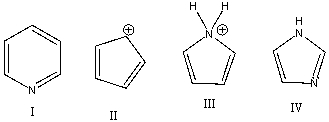
A) I
B) II
C) III
D) IV
E) none of these

A) I
B) II
C) III
D) IV
E) none of these

Unlock Deck
Unlock for access to all 98 flashcards in this deck.
Unlock Deck
k this deck
43
Which one of the following compound is nonaromatic? 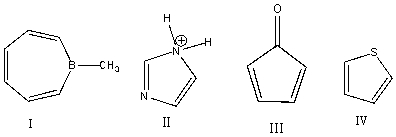
A) I
B) II
C) III
D) IV

A) I
B) II
C) III
D) IV

Unlock Deck
Unlock for access to all 98 flashcards in this deck.
Unlock Deck
k this deck
44
Which one of the following compound is nonaromatic? 
A) I
B) II
C) III
D) IV
E) V

A) I
B) II
C) III
D) IV
E) V

Unlock Deck
Unlock for access to all 98 flashcards in this deck.
Unlock Deck
k this deck
45
Classify the following compounds as aromatic, antiaromatic, or nonaromatic. Explain your choice. 


Unlock Deck
Unlock for access to all 98 flashcards in this deck.
Unlock Deck
k this deck
46
Which one of the following compound is aromatic? 
A) I
B) II
C) III
D) IV

A) I
B) II
C) III
D) IV

Unlock Deck
Unlock for access to all 98 flashcards in this deck.
Unlock Deck
k this deck
47
Classify the following compound as aromatic, antiaromatic, or nonaromatic. Explain your choice. 


Unlock Deck
Unlock for access to all 98 flashcards in this deck.
Unlock Deck
k this deck
48
Classify the following compound as aromatic, antiaromatic, or nonaromatic. Explain your choice. 


Unlock Deck
Unlock for access to all 98 flashcards in this deck.
Unlock Deck
k this deck
49
Classify the following compound as aromatic, antiaromatic, or nonaromatic. Explain your choice. 


Unlock Deck
Unlock for access to all 98 flashcards in this deck.
Unlock Deck
k this deck
50
Classify the following compounds as aromatic, antiaromatic, or nonaromatic. Explain your choice. 


Unlock Deck
Unlock for access to all 98 flashcards in this deck.
Unlock Deck
k this deck
51
Which one of the following compound is aromatic? 
A) I
B) II
C) III
D) IV
E) None of these

A) I
B) II
C) III
D) IV
E) None of these

Unlock Deck
Unlock for access to all 98 flashcards in this deck.
Unlock Deck
k this deck
52
Classify the following compound as aromatic, antiaromatic, or nonaromatic. Explain your choice. 


Unlock Deck
Unlock for access to all 98 flashcards in this deck.
Unlock Deck
k this deck
53
Which one of the following compounds is aromatic? 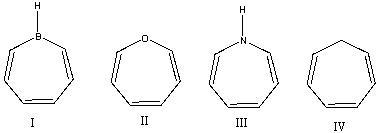
A) I
B) II
C) III
D) IV

A) I
B) II
C) III
D) IV

Unlock Deck
Unlock for access to all 98 flashcards in this deck.
Unlock Deck
k this deck
54
Which one of the following compounds is antiaromatic? 


Unlock Deck
Unlock for access to all 98 flashcards in this deck.
Unlock Deck
k this deck
55
Classify the following compound as aromatic, antiaromatic, or nonaromatic. Explain your choice. 


Unlock Deck
Unlock for access to all 98 flashcards in this deck.
Unlock Deck
k this deck
56
Which one of the following compound is aromatic? 
A) I
B) II
C) III
D) IV

A) I
B) II
C) III
D) IV

Unlock Deck
Unlock for access to all 98 flashcards in this deck.
Unlock Deck
k this deck
57
Classify the following compound as aromatic, antiaromatic, or nonaromatic. Explain your choice. 


Unlock Deck
Unlock for access to all 98 flashcards in this deck.
Unlock Deck
k this deck
58
Which of the following annulenes is not aromatic?
A) [6]-Annulene
B) [14]-annulene
C) [16]-annulene
D) [18]-annulene
E) [22]-annulene
A) [6]-Annulene
B) [14]-annulene
C) [16]-annulene
D) [18]-annulene
E) [22]-annulene

Unlock Deck
Unlock for access to all 98 flashcards in this deck.
Unlock Deck
k this deck
59
Which one of the following compound(s) is antiaromatic? 
A) I
B) II
C) III
D) IV
E) none of these

A) I
B) II
C) III
D) IV
E) none of these

Unlock Deck
Unlock for access to all 98 flashcards in this deck.
Unlock Deck
k this deck
60
Classify the following compound as aromatic, antiaromatic, or nonaromatic. Explain your choice. 


Unlock Deck
Unlock for access to all 98 flashcards in this deck.
Unlock Deck
k this deck
61
Provide the structures of the intermediate and final products in the following reaction sequence. 


Unlock Deck
Unlock for access to all 98 flashcards in this deck.
Unlock Deck
k this deck
62
Provide the structure of the major product(s) for the following reaction. 

A) I
B) II
C) III
D) IV
E) V


A) I
B) II
C) III
D) IV
E) V

Unlock Deck
Unlock for access to all 98 flashcards in this deck.
Unlock Deck
k this deck
63
Provide the reagents necessary to carry out the following conversion. 


Unlock Deck
Unlock for access to all 98 flashcards in this deck.
Unlock Deck
k this deck
64
The pKa of cyclopentadiene (I) and cycloheptatriene (II) is around 16 and 36 respectively. Explain the difference in the two pKa values. 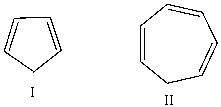


Unlock Deck
Unlock for access to all 98 flashcards in this deck.
Unlock Deck
k this deck
65
Both pyridine and pyrrole are nitrogen containing aromatic heterocyclic compounds. When treated with HCl, only pyridine forms the hydrochloride salt, where as pyrrole is unreactive. Provide an explanation for this observed reactivity. 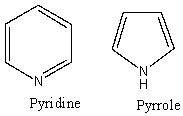


Unlock Deck
Unlock for access to all 98 flashcards in this deck.
Unlock Deck
k this deck
66
Provide the product for the following reaction? 

A) I
B) II
C) III
D) IV
E) V


A) I
B) II
C) III
D) IV
E) V

Unlock Deck
Unlock for access to all 98 flashcards in this deck.
Unlock Deck
k this deck
67
Provide the reagents necessary to convert ethylbenzene to styrene.

Unlock Deck
Unlock for access to all 98 flashcards in this deck.
Unlock Deck
k this deck
68
Provide the product for the following reaction? 

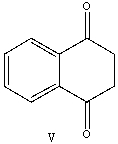
A) I
B) II
C) III
D) IV
E) V



A) I
B) II
C) III
D) IV
E) V

Unlock Deck
Unlock for access to all 98 flashcards in this deck.
Unlock Deck
k this deck
69
Which one of the following compounds is most acidic? 
A) I
B) II
C) III
D) IV
E) none of these

A) I
B) II
C) III
D) IV
E) none of these

Unlock Deck
Unlock for access to all 98 flashcards in this deck.
Unlock Deck
k this deck
70
Provide the structure of the major product(s) for the following reaction. 


Unlock Deck
Unlock for access to all 98 flashcards in this deck.
Unlock Deck
k this deck
71
Provide the reagents necessary to carry out the following conversion. 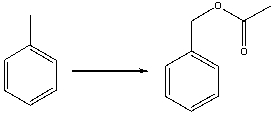


Unlock Deck
Unlock for access to all 98 flashcards in this deck.
Unlock Deck
k this deck
72
Which one of the following compounds will undergo the fastest SN1 reaction?
Explain your choice.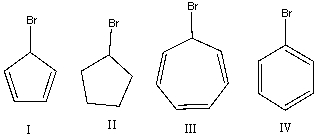
Explain your choice.


Unlock Deck
Unlock for access to all 98 flashcards in this deck.
Unlock Deck
k this deck
73
Which of the following compounds is most acidic? 
A) I
B) II
C) III
D) both I & II
E) both II & III

A) I
B) II
C) III
D) both I & II
E) both II & III

Unlock Deck
Unlock for access to all 98 flashcards in this deck.
Unlock Deck
k this deck
74
Which one of the following compounds will undergo the fastest SN1 reaction?
Explain your choice.
Explain your choice.


Unlock Deck
Unlock for access to all 98 flashcards in this deck.
Unlock Deck
k this deck
75
Provide the product for the following reaction? Explain your answer. 


Unlock Deck
Unlock for access to all 98 flashcards in this deck.
Unlock Deck
k this deck
76
Provide the structure of the major product(s) for the following reaction. 
A) I
B) II
C) III
D) IV
E) V

A) I
B) II
C) III
D) IV
E) V

Unlock Deck
Unlock for access to all 98 flashcards in this deck.
Unlock Deck
k this deck
77
Which one of the following compounds is most acidic? 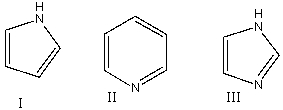
A) I
B) II
C) III
D) I & III
E) II & III

A) I
B) II
C) III
D) I & III
E) II & III

Unlock Deck
Unlock for access to all 98 flashcards in this deck.
Unlock Deck
k this deck
78
Which one of the following compounds is most acidic? Explain your choice. 


Unlock Deck
Unlock for access to all 98 flashcards in this deck.
Unlock Deck
k this deck
79
Provide the structure of the major product(s) for the following reaction. 
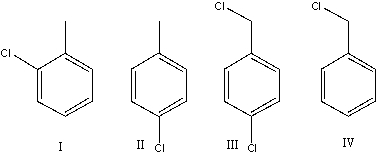
A) I
B) II
C) III
D) IV
E) Both I and II


A) I
B) II
C) III
D) IV
E) Both I and II

Unlock Deck
Unlock for access to all 98 flashcards in this deck.
Unlock Deck
k this deck
80
Provide the structure of the major product(s) for the following reaction. 


Unlock Deck
Unlock for access to all 98 flashcards in this deck.
Unlock Deck
k this deck



